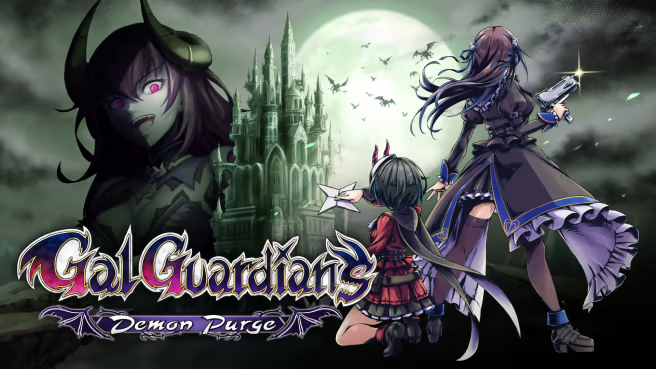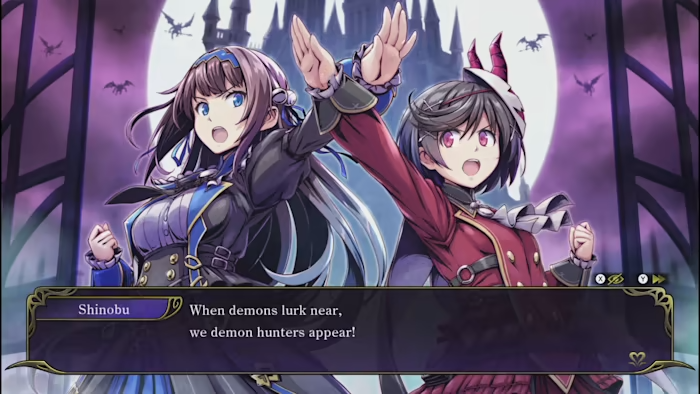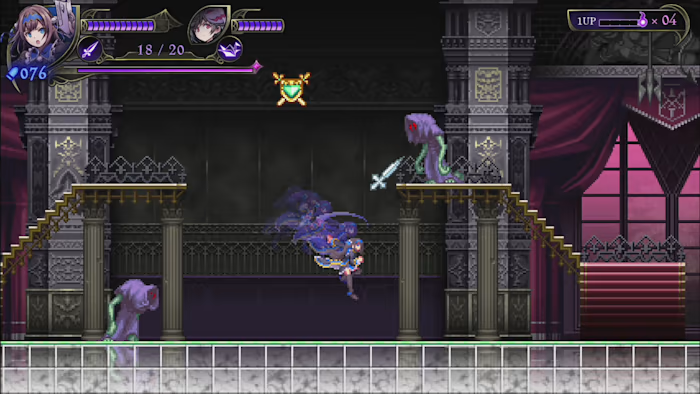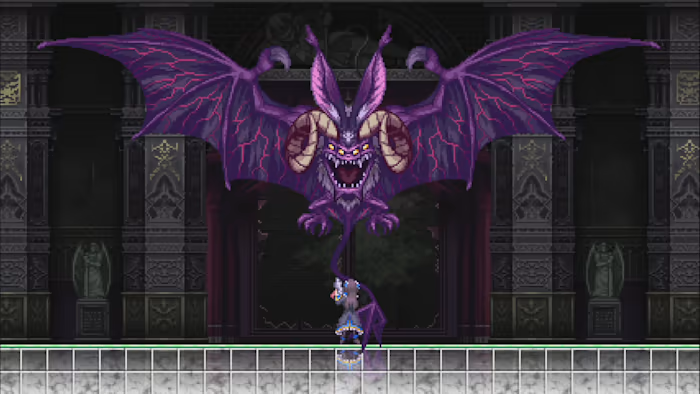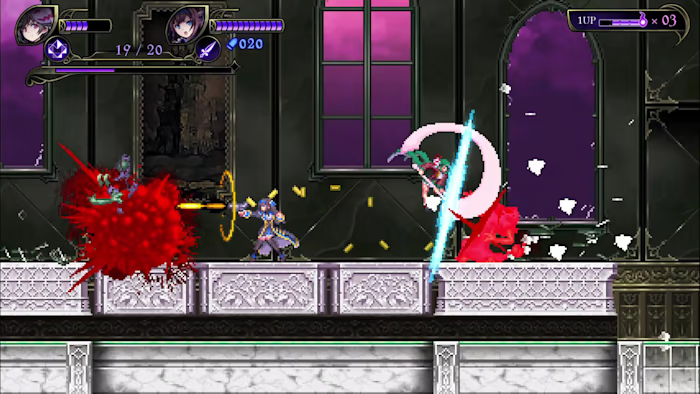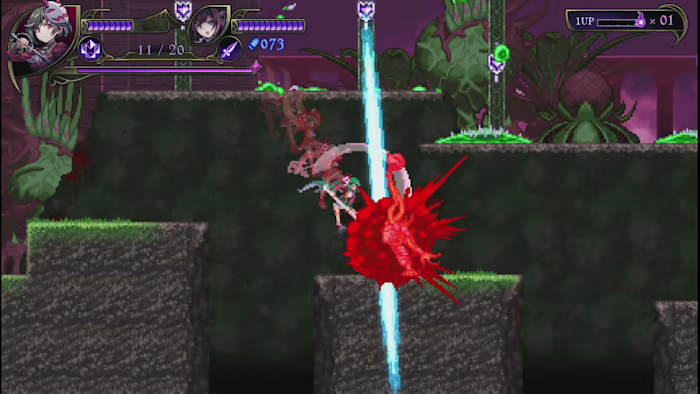I’m a pretty big fan of video game developer Inti Creates. This much should be no surprise to long-time readers of this website. However, I do not care for all of their output. Quite specifically, I have gone to great lengths to avoid the Gal*Gun series, which, as I understand it, is a rail shooter/dating sim that is just a wee bit too pervy for my tastes.
However! I did very recently play the newest Inti Creates game, Gal Guardians: Demon Purge, which is a Gal*Gun spin-off. Partly because I did not realize that it’s a Gal*Gun spin-off until I was about 5 hours in, but also mostly because it’s a 2D action platformer that looks and plays a heck of a lot like Castlevania. It is my personal opinion that nobody does 2D action platformers as well as Inti Creates (since neither Konami or Capcom make them anymore), so I wasn’t going to pass it up even if I had known about the Gal*Gun connection.
Gal Guardians is a game about two sibling demon hunters, Shinobu and Maya, who take up the fight to save their classmates after a demon fuses their school with the demon world. It’s not an especially deep story and never really grows into anything more. The writing is actually quite silly and groan-worthy, being filled with pop-culture references and unafraid to get a little risqué. Of course, that much would likely have been obvious to anyone familiar with the game’s background. That’s not to say it’s bad, though! In fact, I’d say that the jokes and references made me chuckle almost as often as they made me cringe.
We don’t play games that look like Castlevania for the story, though. No, it’s all about the gameplay and atmosphere! Beginning with the latter, yeah, I’d say that Gal Guardians nails the atmosphere that it’s going for. On the surface, you have the girls traversing a big, spooky castle filled with monsters that splatter blood all over the walls when killed. All the usual stage themes are represented, such as the main hall, a library, an underground cavern, a clock tower, et cetera, et cetera. While I would normally wag my finger at a game being so paint-by-numbers, each area has been given enough personality of its own that it never felt like I was actually just playing through an uninspired copy of a Castlevania game.
That said, there’s also a lot of Gal*Gun influence that, in any other circumstance, would totally undermine the horror vibe. But I can let it slide here, because that’s exactly the point. The goofy dialogue, the general anime-ness, and the light sexual themes are all central pillars of the Gal*Gun series, so it would be wrong to omit them here. In fact, looking at it from that angle, it would actually be the horror vibe that doesn’t belong! Either way, while it’s not something I’d want to see more often, the contrasting tones work well enough in this very specific instance. To contrast, Blaster Master Zero 2 leaned into the ridiculous, pervy anime stuff without precedent, and at least in my opinion, the game was poorer for it. Totally threw off the vibe. I wouldn’t say it ruined the experience by any means, but I wish I would have known ahead of time so I could have avoided playing it on the bus.
Where Gal*Guardieans shines brightest is no doubt the gameplay. And that’s important because since Inti Creates has been doing this kind of thing very, very well for decades, I expect no less than the best from them. As always, chief among the various aspects of the nebulous “gameplay” elements are the controls, and I’m happy to say that control is very tight in Gal Guardians. The girls are responsive, the physics are intuitive, and it all just feels so natural. You can even remap the controls if you so choose, but that should just be an industry standard for all video games at this point *glares in Nintendo’s direction*. My one and only complaint is that I feel like tapping the control pad moves your character just a bit too much. Which is a tiny complaint! Barely worth mentioning in fact, but there were a few times where I needed to just turn the character in the opposite direction and she took a full step and got hit as a result, so a mention is necessary.
While I have been comparing Gal Guardians to Castlevania thus far, in reality it’s a 16-bit spiritual successor to Inti Creates’ two Bloodstained: Curse of the Moon games. In fact, I would reckon that they simply took the code from those games, then updated the visuals and popped in a new script. Otherwise, it’s exactly the same! The game progression structure, the branching paths of each level, the character-swapping mechanic – it’s all going to feel incredibly familiar to anyone who’s spent any length of time playing either of those games, but not quite exactly the same. Though it’s not going to feel at all like Bloodstained: Ritual of the Night, because that’s a totally different game from a totally different developer. I mention that just to clarify that anytime I mention Bloodstained from here on out, I’ll only be referring to the COTM duology.
Gal Guardians starts off as a fairly standard 2D action game, having you progress stage-by-stage in a linear fashion. As you go, though, you’ll no doubt notice many doors and paths that your characters simply cannot reach. Each boss you defeat gives your characters a new subweapon to use, several of which provide the girls additional movement abilities and ways to access otherwise unreachable areas. It all comes to a head once you reach and defeat the main antagonist, at which point you’ll be warped back to the start of the game and told to do it all again. Which is very inconvenient! However, you retain all those subweapons, as well as an innate upgrade for both girls, which means that all those alternate routes you couldn’t take before are now open to you. To further justify the second loop, you’re given a hub area where you can talk to characters you’ve saved, turn in completed sidequests for prizes, and easily warp to any stage you’d like. Also, every boss is upgraded with new attacks that make the rematches a little more interesting.
While the Bloodstained games each give you a party of four characters to play with, gal Guardians limits you to only Shinobu and Maya, and predictably enough, they play very differently from each other. Shinobu fights with a submachinegun, has a suite of (mostly) conventional subweapons like knives and grenades, and has a longer health bar. Maya is the short range character with a short HP bar, using shikigami to form swords and axes as her main weapons, and all sort of wacky things like shields, floating platforms, and spike-breaking dolls as her subweapons. You’re free to swap characters at nearly any time at the press of a button, and knowing the best time to use each sister is paramount to making progress. On the Casual and Veteran difficulty, you’re able to continue playing if one of the girls gets knocked out, and even revive her if you’re able to reach her body, but on Legend difficulty you lose a life if either sister falls. It annoyed me occasionally that you can’t swap characters while mid-jump, but it’s clearly that way for balancing reasons; the ways you could chain subweapons mid-air to break the game are mind-boggling.
Boss fights, as with any 2D action platformer with is salt, seem insanely hard at first, but are actually not that hard to master. While are a couple exceptions, most of the bosses are strictly pattern-based, so once you know what order their attacks happen in, it’s just a matter of figuring where to stand. And for the bosses that don’t stick to a patten? All of their attacks have either an obvious tell or a long wind-up, so it’s not terribly difficult to know what to do on the fly. Of course, as Bloodstained tradition dictates, each boss also has a final desperation attack that launches once their health bar is emptied. I’m happy to say that there are a few creative twists, though! I’d say that taken as a whole, the bosses in Gal Guardians are some of the most fun and satisfying I’ve played in a long time, and I don’t think there’s any better evidence of that than the fact that I bothered to clear the boss rush mode on all three difficulty levels. To add context: I very rarely play optional boss rushes at all.
Upon defeating each boss, you’ll rescue a “main” NPC that ends up hanging out at your base during the second loop. Most of them don’t really do anything but, one provides candy as a reward for beating the V2 bosses, which can then be turned in to another character to upgrade your subweapons. You’ll get a quest from that same girl to find three machine parts hidden throughout the castle, and assembling said machine is how you get the good ending. There’s also a gymnasium that you can walk around in, which is where all the random girls you rescue end up hanging out. Finding all 32 of these optional rescues is how you get the “joke” ending. It’s not exactly up to Silent Hill standards for joke endings, but it’s somewhat humorous. Last on the list of collectibles (but probably the most important) are permanent power-ups for Shinobu and Maya, which increase their HP, attack, defense, subweapon points, and the clip size of Shinobu’s SMG.
Since each stage is fairly big and has a large number of different paths, Inti Creates added in a compass feature that always points in the direction of the boss, but also nearby power-ups, machine parts, and lost girls. The compass only pops up when you press a button though, which makes it very easy to forget that it even exists, which makes it very easy to forget that it exists. Yes, technically that’s a user error, but it’s still annoying. Given the fact that the map is also kind of useless since it only shows the rough shapes of each stage and can only be seen on the stage select screen, it feels like one of the two navigation features could be improved in some way. As it is, neither of them are overly helpful, which resulted in me spending a lot more time wandering around fruitlessly than I really should have.
Another facet of Gal Guardians that could be tuned just slightly better is the difficulty level. Initially, players can choose between Casual and Veteran difficulty. I think that Casual removes knockback and gives you infinite lives, maybe something else? I don’t know, but I chose Veteran. At the outset, the game was somewhat challenging, but by the end I was flying through stages, beating bosses without taking damage, and has accumulated over 40 lives. And that’s fine! My proficiency was born from having played tons of games like this, and because I actively made an effort to use my subweapons effectively. Really, the only thing I’d change is to remove the ability to earn lives by defeating enemies. Or make the threshold way higher. I feel like a system that often ends up giving you 2 extra lives for beating a boss is just a wee bit too lenient. Having the ability to revive downed characters is a little bit OP, and thanks to it I only lost three lives throughout my entire time playing the game.
When you beat the game you unlock Legend mode, which respawns enemies when you leave a screen, increases the damage you take, and will take one of your lives if either sister falls. It sounds very hard! But it only unlocks after you’ve beaten the game once, so in theory anyone playing Legend mode should already have a good grasp on the game’s mechanics. Normally I don’t go back to games to play on the unlockable hard modes, but I’m actually considering giving this one a shot. Not only because I like the game enough to play it again, but also because I like it enough to want to invest the time and energy into truly mastering it.
No video game can be perfect, however, and I’ve already touched on my biggest complaint about Gal Guardians, but I think it ought to be discussed just a little bit more. This game is unfortunately very happy to be more than a little bit perverted. It’s not something that comes up often, but when it does, it goes hard. Like the boss that’s an extended tentacle rape joke (though the “victim” does seem to enjoy the situation). Or when the only way to get into the final stage is to have Shinobu and Maya dress in bunny girl costumes (complete with a unique illustration that highlights their assets). Or the secret final boss fight that switches into a Gal*Gun-esque first-person shooter mode where you have to tickle and shoot the boss in sensitive areas to bring her to ecstasy. As I said before, it all technically does fit with the series’ themes, but it all still makes me feel a bit gross.
Topping all of it off, though, is the game’s biggest side-quest: collecting all of the girls’ missing undies. Yep. There’s a game-spanning quest to search the castle high and low to find 40 missing pairs of panties. Each with its own unique sprite and bit of dialog from their owner once you turn them in. It’s just… facepalm. It’s also the worst part of the game, mechanically speaking. For one, you can miss the starting point of the quest entirely (which might be a positive?), and the panties don’t spawn until you’ve triggered that flag. That doesn’t sound like a big deal, but imagine having scoured every stage for all the other collectibles, only to learn that you have to do it all again for the undies. Also, there’s absolutely no in-game tracking system to tell you how many panties you’ve found or where you found them, so it’s all up to your memory or notepad. Lastly, the compass doesn’t help at all, since it’ll never point you in the direction of undies. So this quest is intentionally designed to be a massive headache. Sadly, there is an achievement tied to it, so if you’re going for the 100% clear like I did, you’ll have to spend the time tracking down all the missing underwear.
At this point, you may very well be wondering why I haven’t brought up the music yet. I always like to go on about music in video games! Well, the fact of the matter is that I just didn’t really listen to it that much. I was on vacation while playing Gal Guardians, so most of the time I had my Switch’s volume turned down or off completely. What I do remember about the music is that it’s mostly unmemorable. It’s fitting enough and not bad by any means, but I never found myself bopping along, and listening to the OST on YouTube, I barely remembered any of the tracks aside from the boss theme. It’s got the general vibe of Castlevania music down, but none of the compositions were nearly as catchy as ‘Vania tunes usually are. That said, I did find that Beast in Black’s Berserker album paired especially well with the gameplay. So that’s something.
Some final notes that don’t really fit their own paragraph:
- There’s a two-player mode in this game. I never used it. Probably cool though.
- I was shocked by the credits when seeing that each character had a unique voice actor. Throughout the game, I assumed the same woman did the voices for everyone because they all have very similar squeaky anime girl voices.
- None of said voice actors are Cristina Vee, though they all sounds like they could be. I guess she costs too much for IntiCreates?
- I was unbelievably sleep-deprived for at least half of my playtime. This fact isn’t especially germane to the actual quality of the game, though I can’t help but wonder if it coloured my opinions of it in some way.
While there are definitely some facets of it that I’m not crazy about, overall I was very satisfied by my time playing Gal Guardians. So much so, in fact, that I might be considering making a place for it on my 2023 Game of the Year list. The gameplay just so finely tuned that it’s quite difficult to put down once you get into it. And a full clear -including achievements- only took about 16 hours, so it’s not too much of a commitment for old folks like me whose free time is precious. Would I recommend it? Yes, absolutely! …As long as you can stomach the more questionable content. It’s not as if there are any new actual Castlevania games being made, but even if there were, I’d definitely still give this homage a big ol’ stamp of approval.

